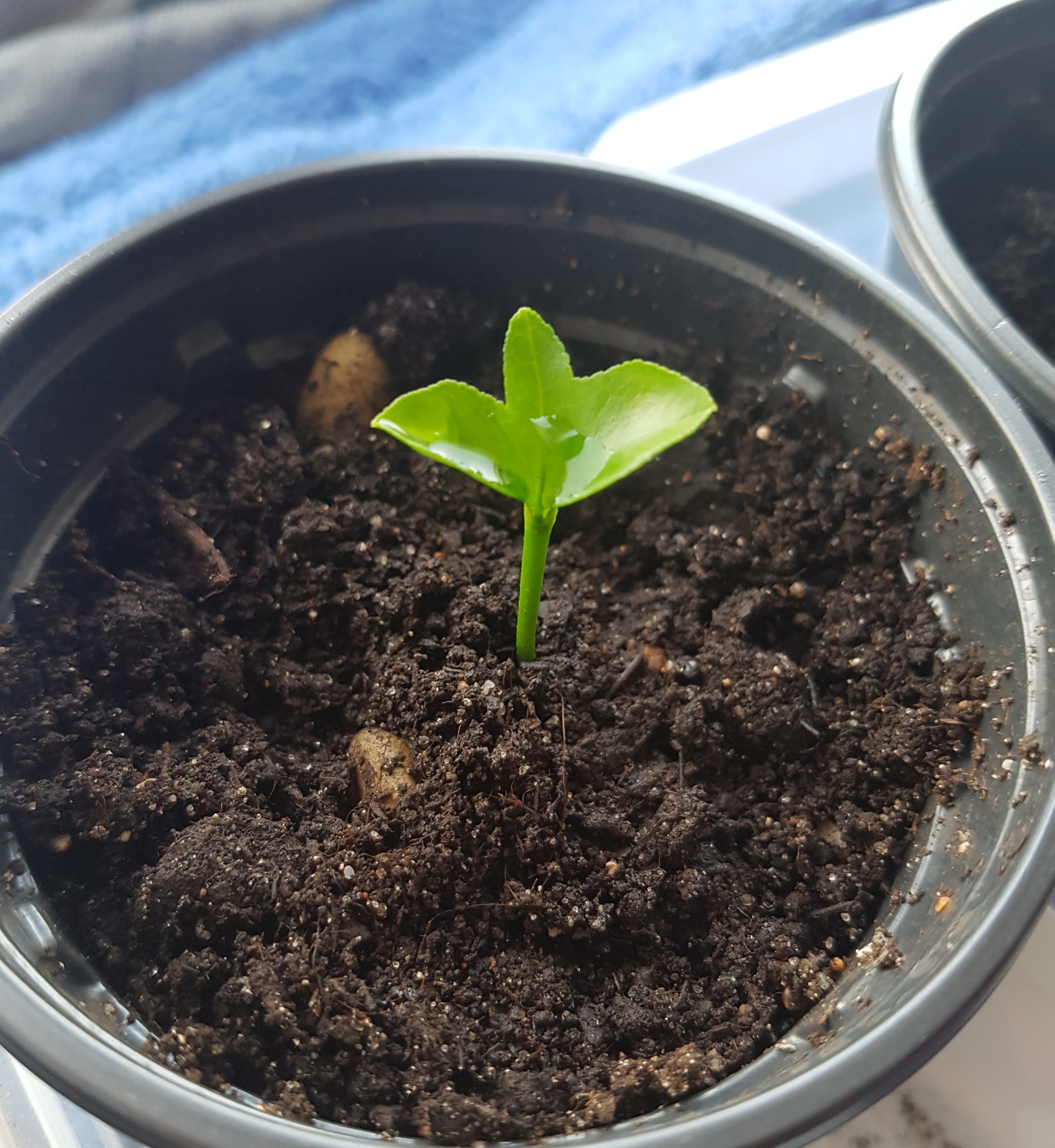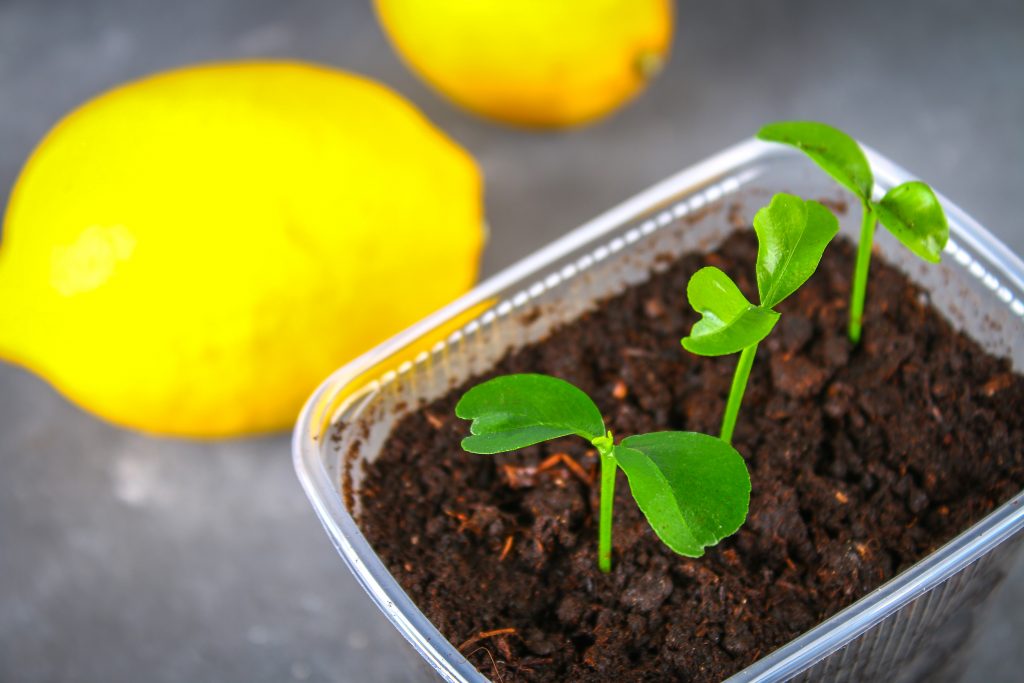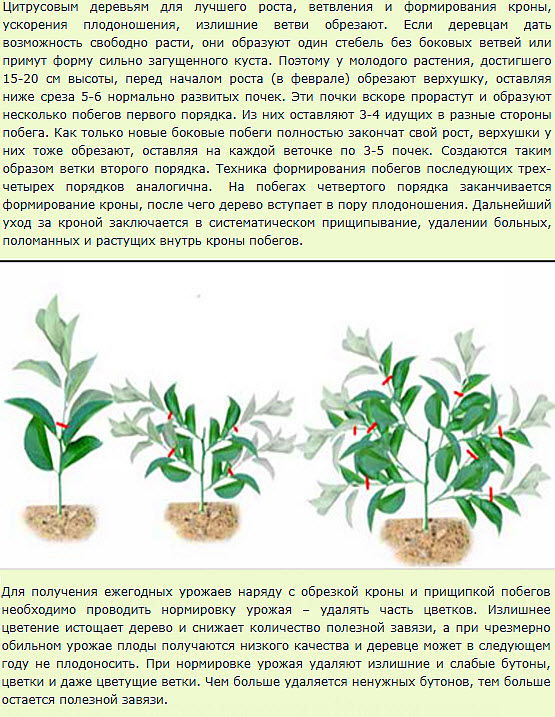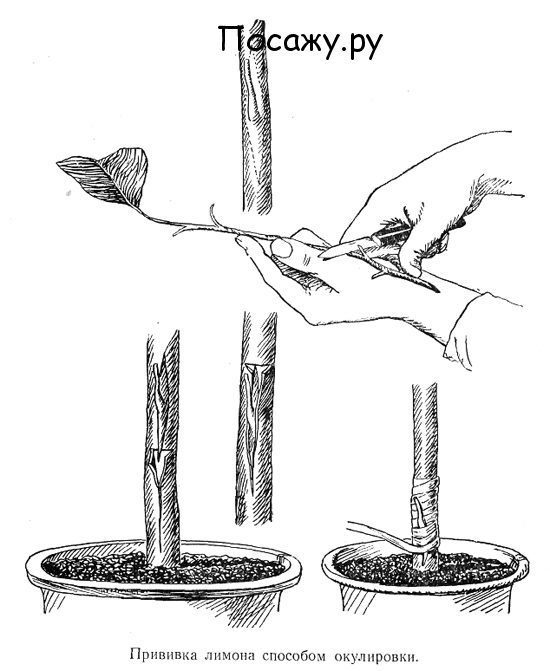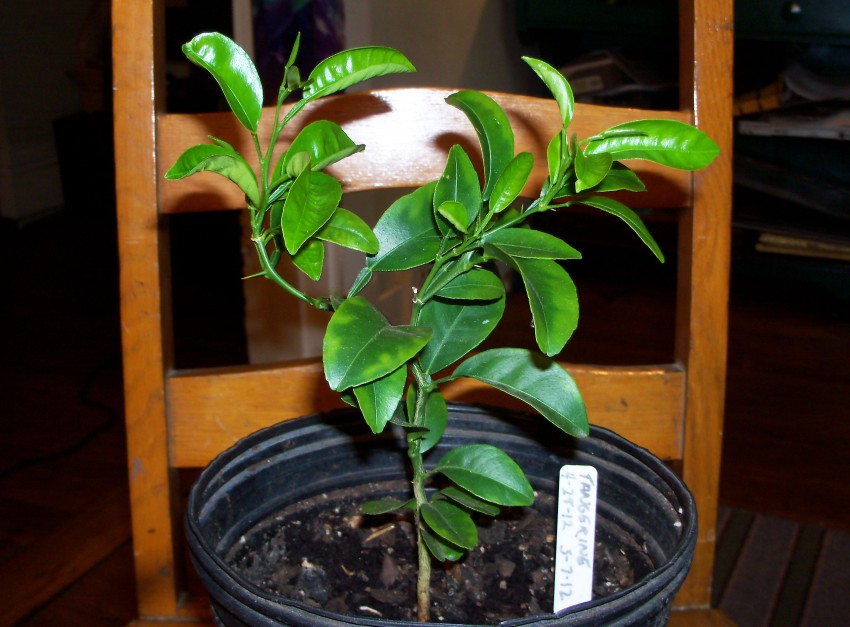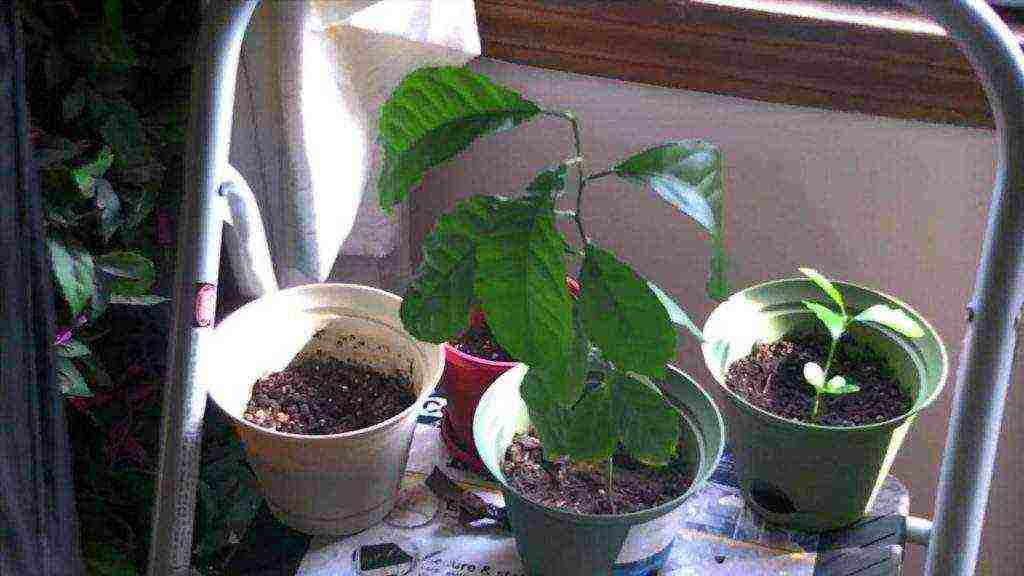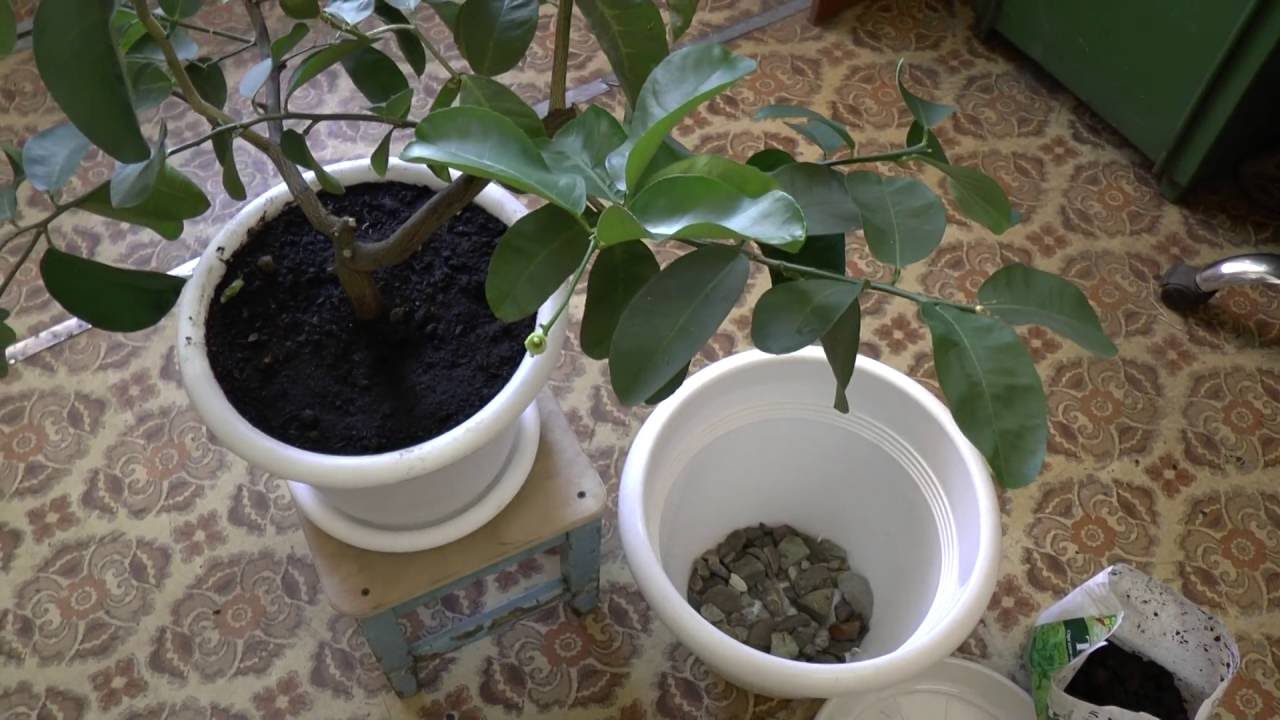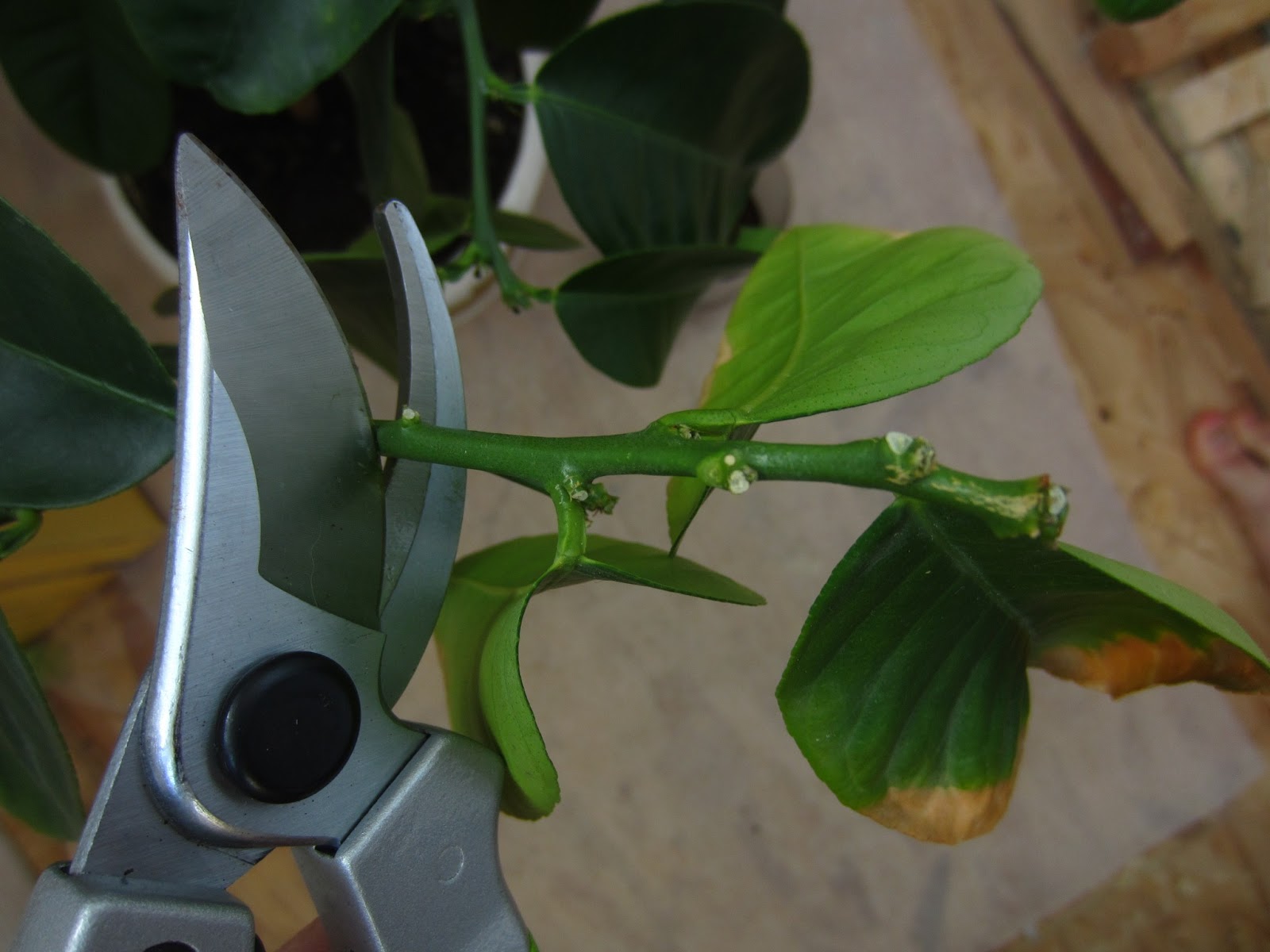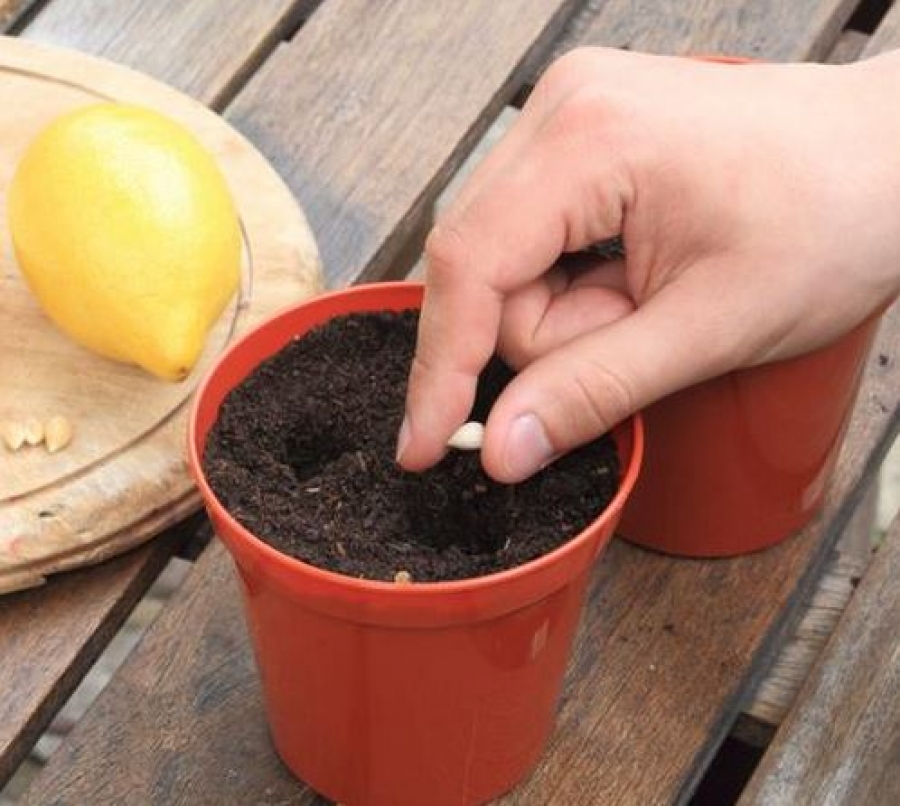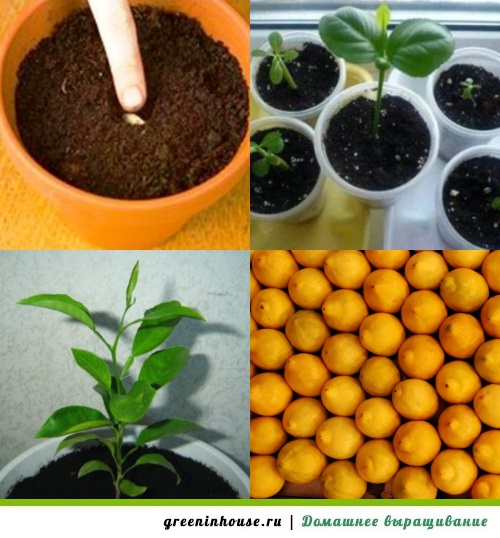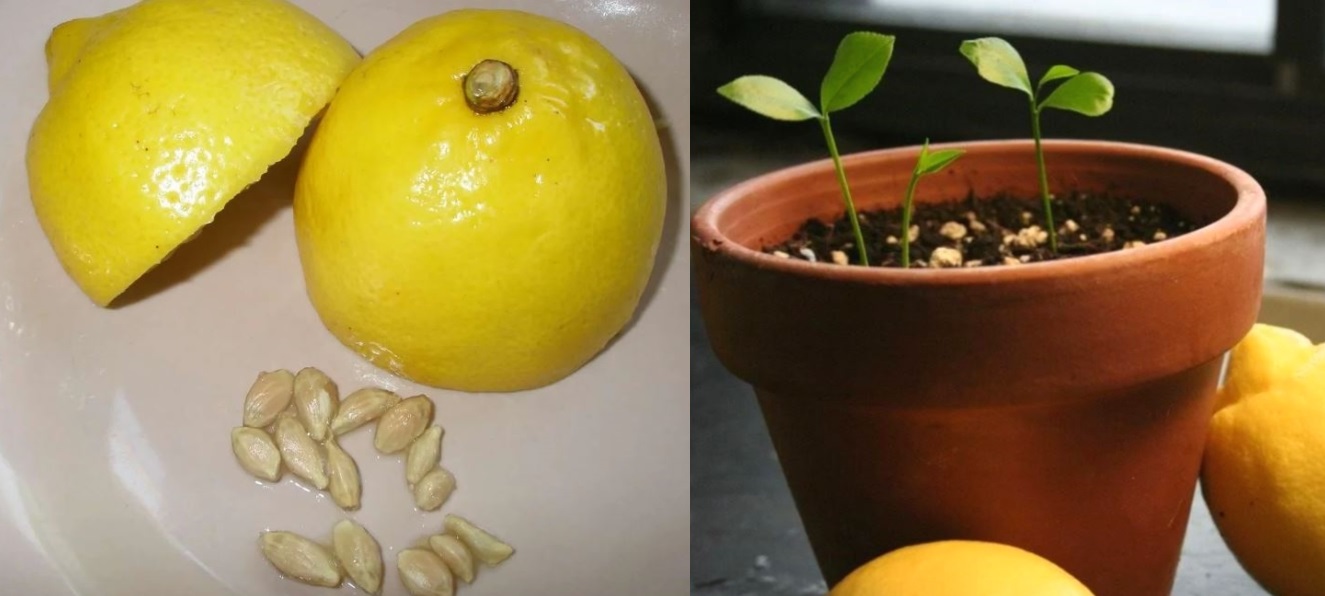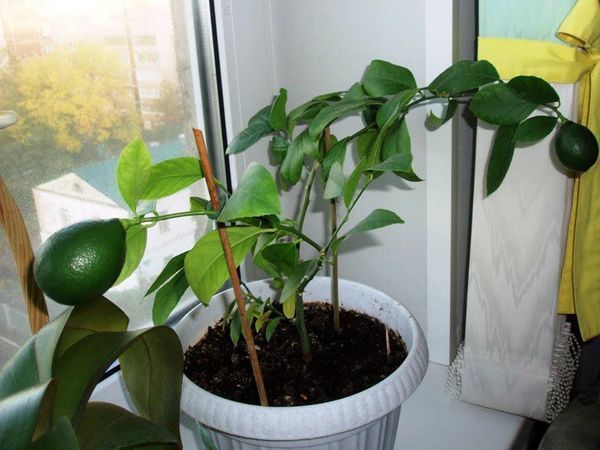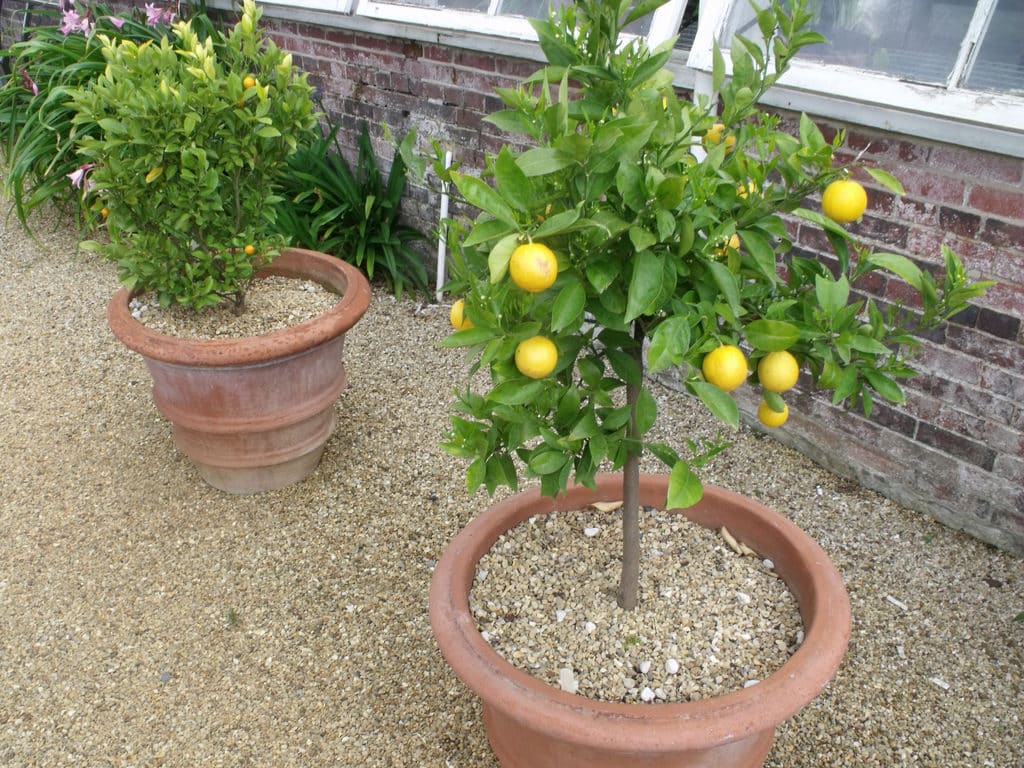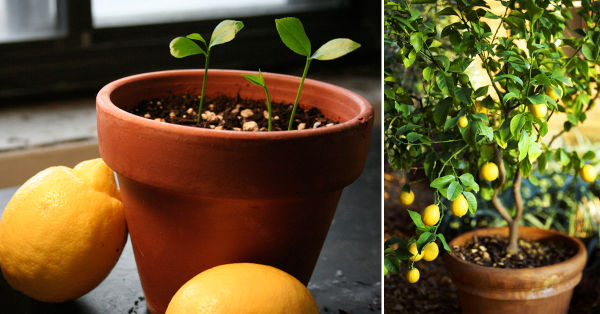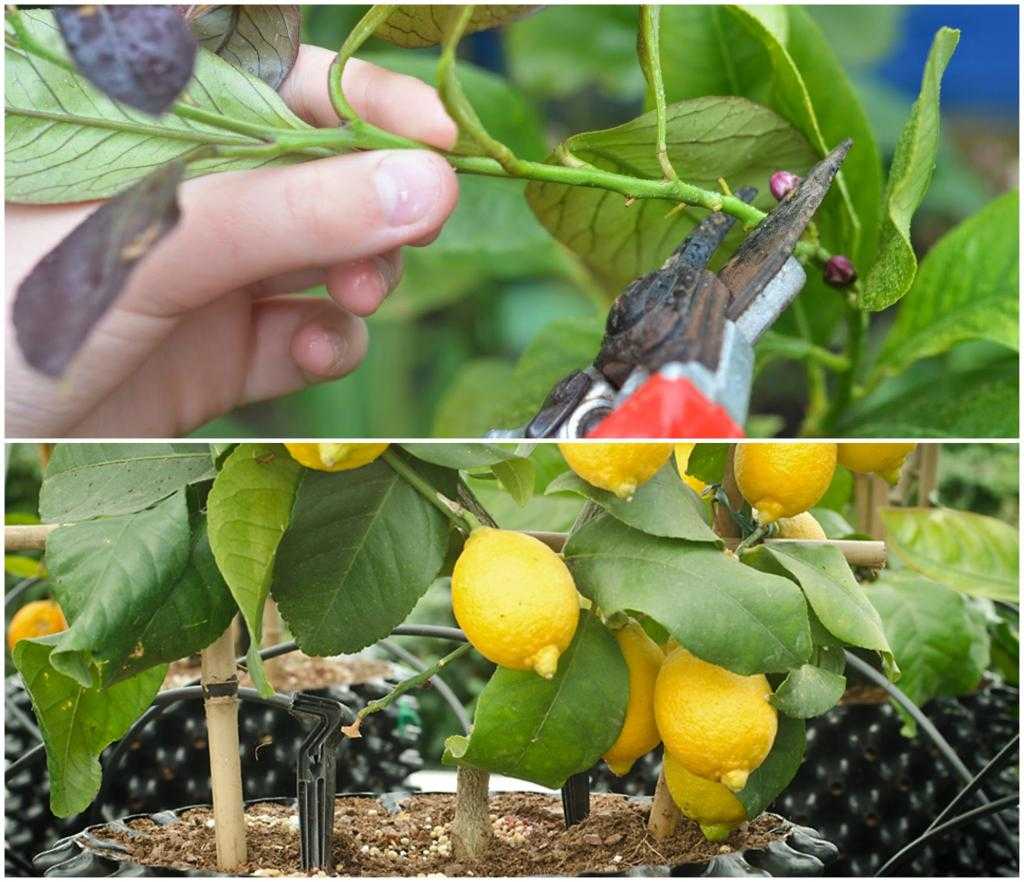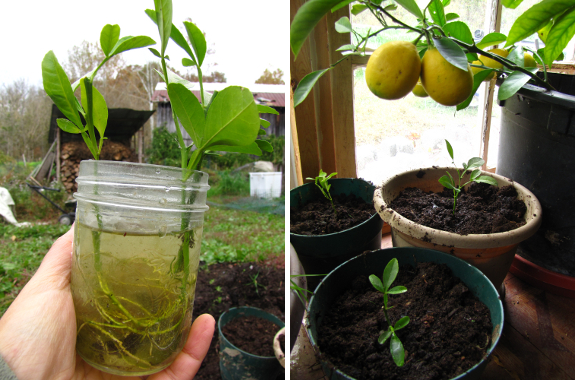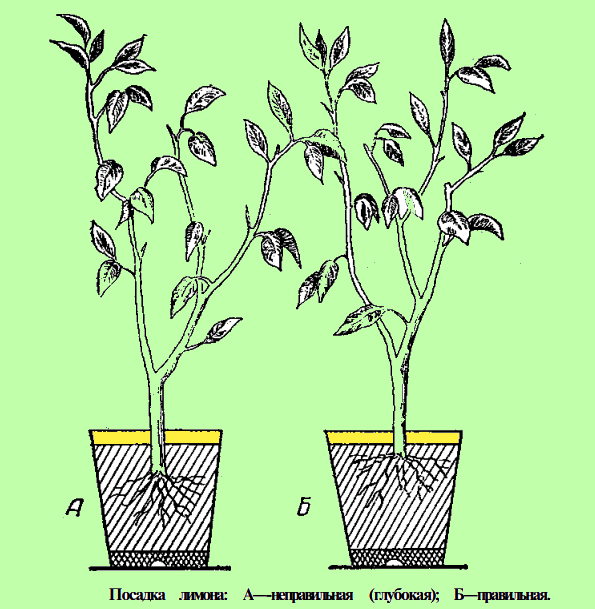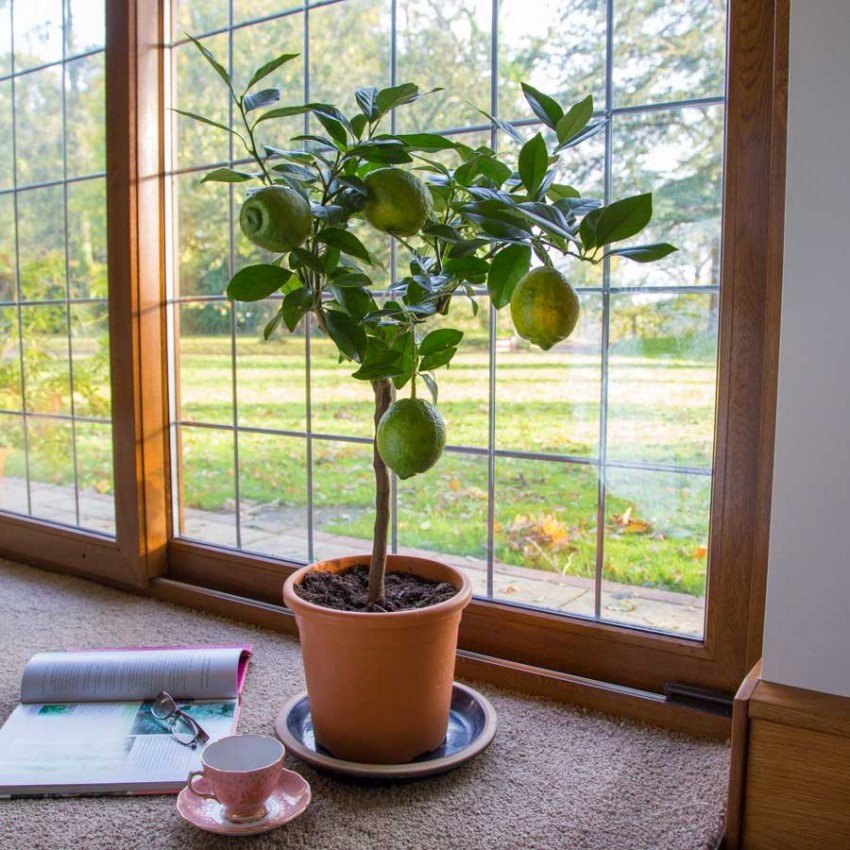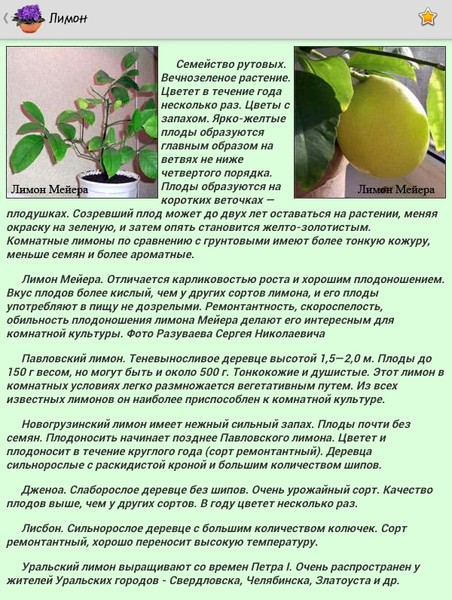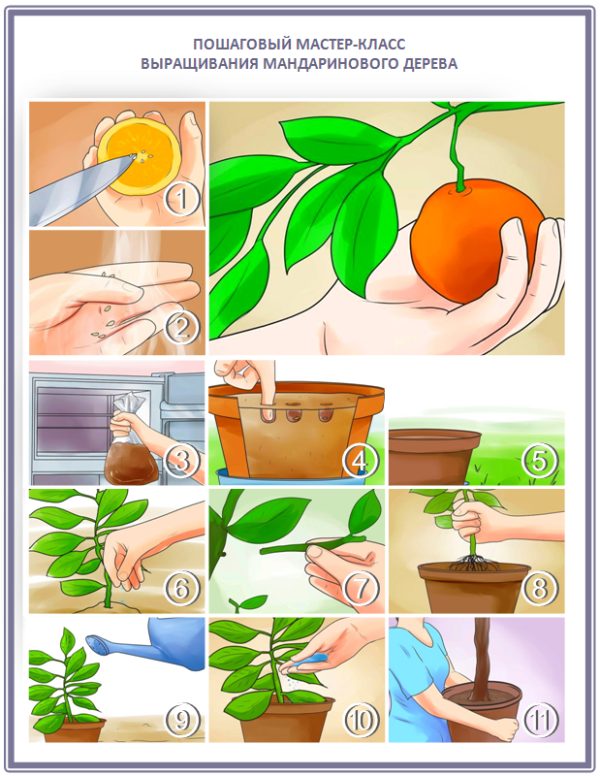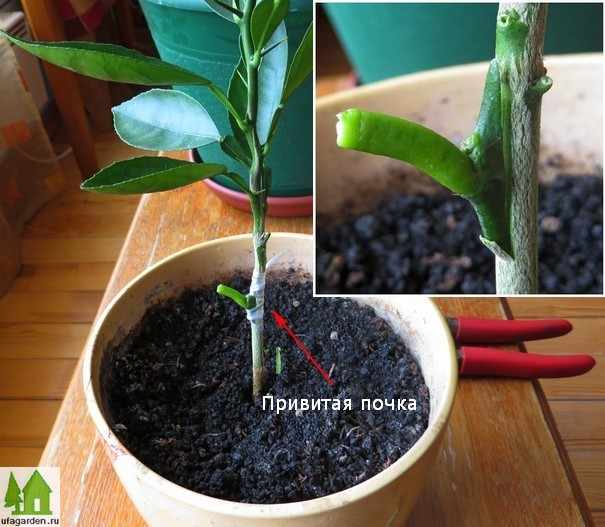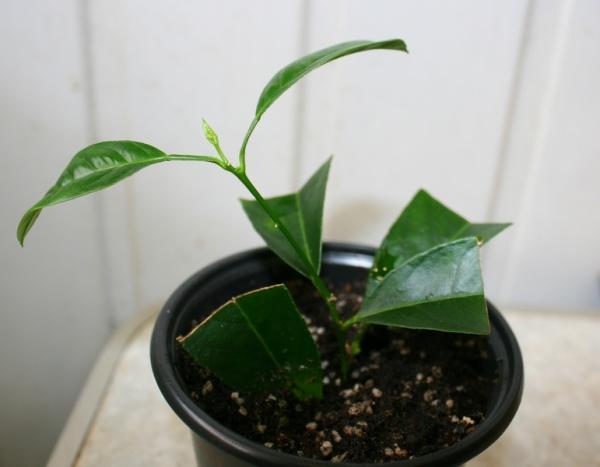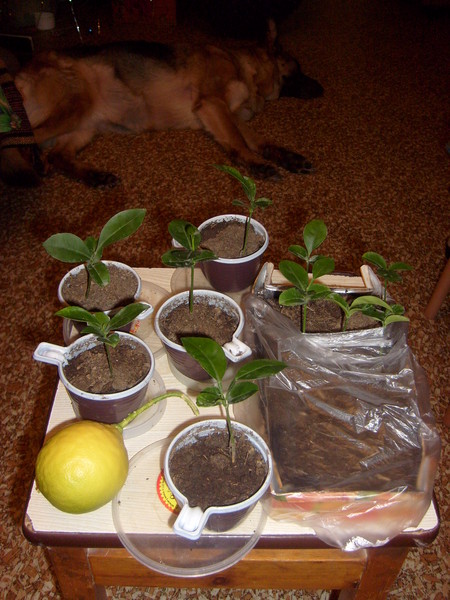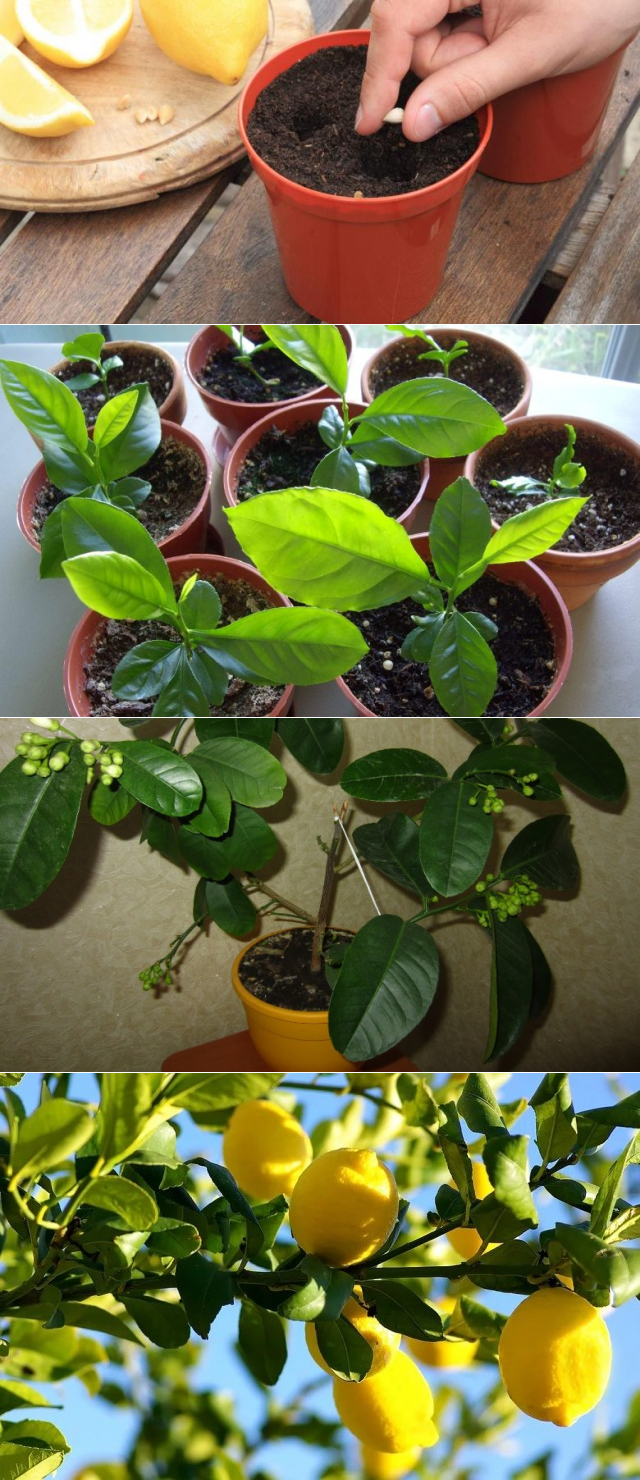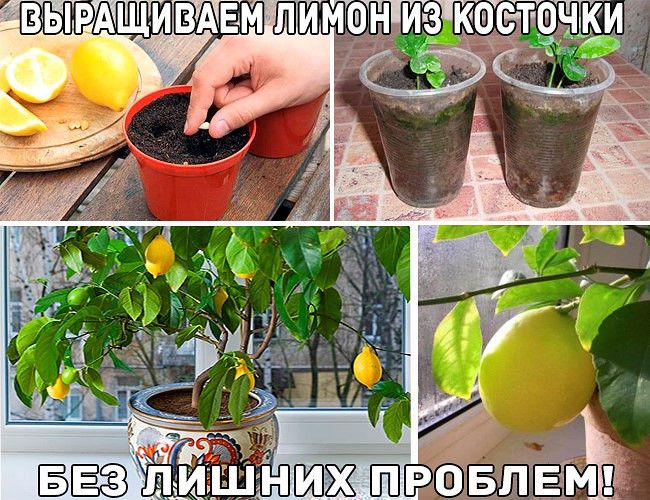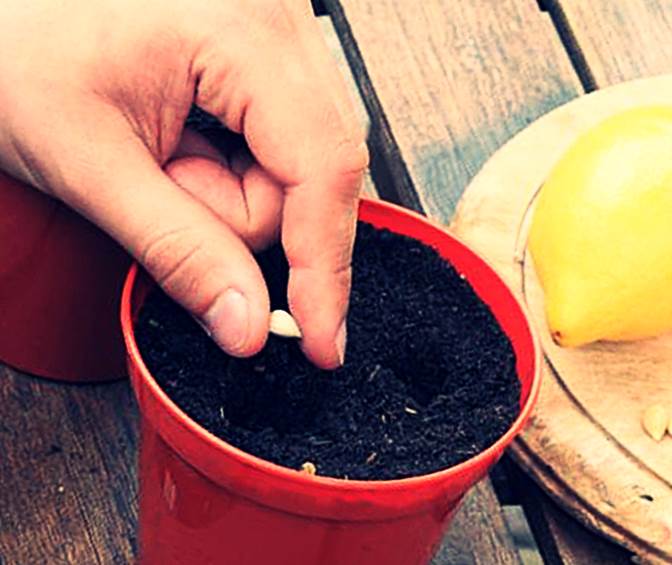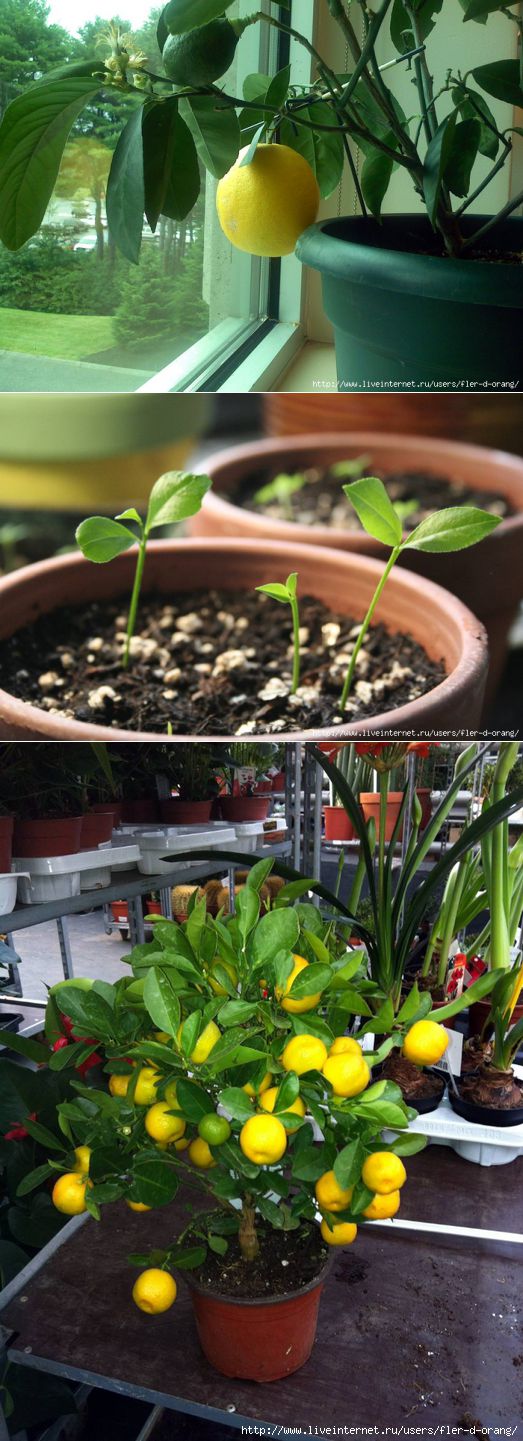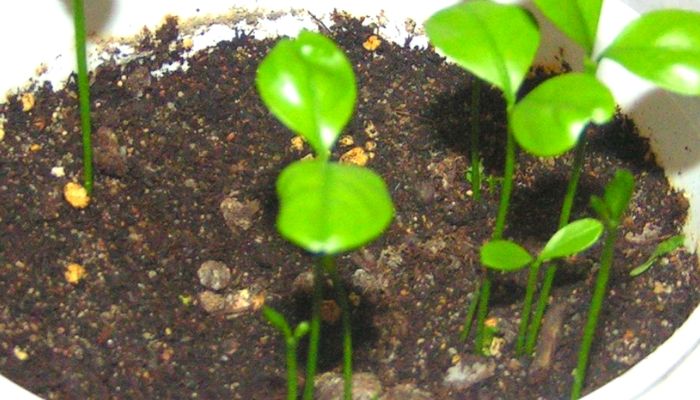Lemon care at home
Proper care of homemade lemon depends not only on the health of the plant, but also on its development, flowering and, accordingly, fruiting.
With the emergence of sprouts above the surface of the earth, they gradually become accustomed to indoor conditions, airing and opening the shelter. When 3-4 leaves appear on the plant, the film is removed altogether. The seedlings are sorted and transplanted into separate small pots.
Watering

In spring and summer, the plant is watered with warm water 1-2 times a day. In winter, moderate and rare watering is carried out 1-2 times a week. Overdrying the earth leads to shedding of leaves. Excessive moisture causes the lemon to die. Neither one nor the other should be allowed!
Watering has been reduced since October. The earth is periodically loosened.
Lemon in the summer requires regular spraying. If the plant is kept in a room with central heating in winter, then it needs spraying in winter. Air humidity should be 60-70%, at air temperatures up to 20 degrees Celsius.
Formation
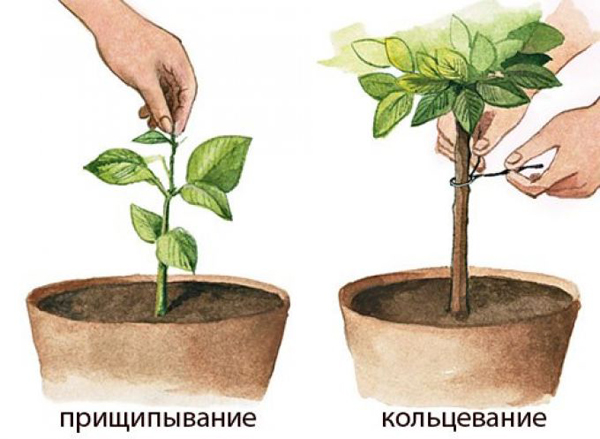
In order for a tree to have a neat crown, it is necessary to shape it. At the same time, shoots growing inside the crown are removed. The rest of the shoots are pinched after 4 leaves grow on them.
When forming an adult, fruiting tree, it is taken into account that at least 10 developed leaves are left for each ripening fruit. All other fruits are removed, otherwise the harvest may not be obtained at all.
Top dressing
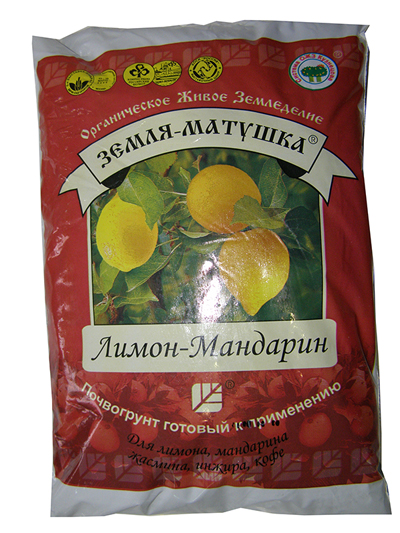
Top dressing for lemon is very important as the plant is cultivated in a confined space.
Lack of nutrients leads to yellowing of the leaves and wilting of the plant. An oversupply of fertilizer also negatively affects the health of the plant.
Top dressing from spring to late summer is carried out every 2 weeks. In winter, the amount of dressing is reduced to 1 time per month. Humic fertilizers or Lemon-Mandarin, Mother Earth, are best suited for feeding. When feeding, dry and liquid feeding alternate. The inside of the leaves is also sprayed with a fertilizer solution.
The first feeding of the lemon after the transplant is carried out in 3-4 weeks. The main dose is given 2-3 days before the tree is transplanted. After transplanting, the plant is watered with Cornesil.
How do you get the fruits?
To obtain fruit from a lemon grown from a stone, you need to graft cuttings of a cultivated specimen to the plant or carry out a number of activities that contribute to fruiting.
When does a lemon begin to bear fruit?
Lemon grown from seed bears fruit at 4–8 years of age. The timing of fruiting depends on the varietal characteristics of the plant.
Wildlife often grows from the seeds of hybrid lemons. It is possible to understand whether the tree will begin to bear fruit soon, and what fruits it will have, by the external signs of the tree. Cultivated lemon trees have few thorns on their shoots. If the tree is thorny, then it is perfect for grafting.
Graft
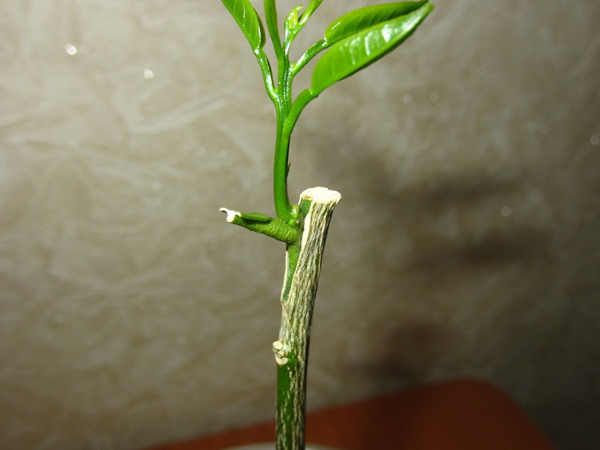
For a lemon grown from a seed, copulation in stock is considered the best option.
The thickness of the plant to be grafted must match the thickness of the pencil. The graft and rootstock must match in diameter and thickness.
Vaccination can be done even in winter. To do this, the young lemon is pruned where the grafting will take place. Oblique cuts are made on the rootstock.
Next, cuttings are prepared from a fruiting lemon tree with 2-4 buds. All leaves are removed. Similar oblique cuts are made on the cuttings. The rootstock and the scion are cut to the cut, tied tightly to each other with tape, tape.
The grafted plant is covered with a plastic bag.Gradually, over the course of several months, the cuttings learn to grow without a bag. If new shoots grow on the plant below the graft, they are removed.
Planting and caring for lemon
- Flowering: at home - at different times.
- Lighting: plant with short daylight hours. The best place in the apartment is the southern and eastern window sills with shade from the sun in the afternoon. In order for the lemon to develop symmetrically, it must be rotated 10˚ every 10 days. In winter, you will need additional artificial lighting for 5-6 hours daily.
- Temperature: during the growth period - 17 degrees, during the budding period - no more than 14-18 degrees, during the growth of fruits - 22 degrees or more. In winter - 12-14 degrees. Watering: from May to September - daily, then no more than 2 times a week.
- Air humidity: systematic spraying of leaves with warm boiled water is recommended, especially in summer heat and in winter, when central heating is working.
- Top dressing of lemon: complex mineral fertilizers. During the period of active growth, young plants are fed once every one and a half months, adults - once every 3-4 weeks. From the middle of autumn, fertilizing is gradually reduced: if the lemon grows in a heated room in winter, it is fed once every one and a half months, if the tree has passed into a dormant period, it does not need fertilizing. The fertilizer solution is applied to a pre-moistened substrate.
- During the rest period: in winter, but not pronounced.
- Lemon transplant: in the spring, at the beginning of the period of active growth. Young lemons are transplanted once a year or two, mature ones - once every 2-3 years, when the roots appear from the drainage holes.
- Propagation of lemon: by seeds, cuttings and grafting.
- Lemon pests: whiteflies, spider mites, mealybugs of aphids, root and common, scale insects.
- Lemon diseases: citrus cancer, homoz, chlorosis, tristeza, scab, anthracnose, root rot, viral leaf mosaic, melseco.
Transplanting lemon into a new pot, pruning, forming a crown
Every year, preferably in the spring (beginning of the growing season), a lemon is transplanted. Transplanting should be carried out carefully so that the perennial root system is not disturbed. The transshipment method is the most preferable for this case. Only young specimens are transplanted annually when they reach 3 years of age (some varieties are 5 years old). The transplant is done every 2 or 3 years. It is highly discouraged to carry out this process during flowering or fruiting - the plant can discard inflorescences with fruits.
Do not forget that good drainage at the bottom of the tank is a prerequisite for citrus crops. The size of the pot is also important, because if the capacity is too small, then the plant will not have enough soil or nutrients. Too large a pot will also not work - the soil will sour, and the root system will rot.
Lemon Pot - Size (Diameter):
- small bushes up to 2 years old - about 20 cm;
- plants 3-4 years old - 30 cm;
- young trees 5-6 years old - 35 cm;
- citrus over 7 years old - 45 cm
It is desirable that the pot is made of clay. However, wood, glass, plastic are also acceptable, the main thing is that the container has drainage holes.
It is also better to give the crown a shape, remove excess branches in the spring (April), until the active growth of shoots has begun. At the first formation of the crown, the trunk of the bush is cut to a length of 25-30 cm.
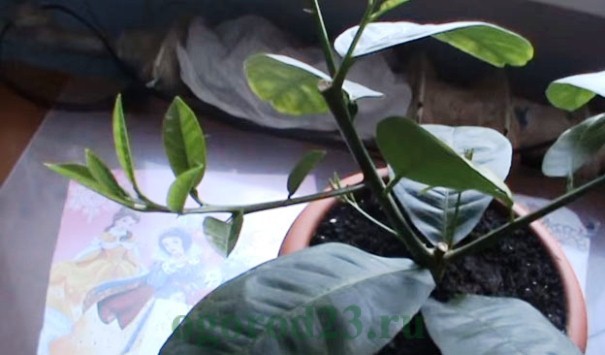
On the sides, the strongest buds remain (these are shoots of the first order), from which skeletal branches will grow later. Usually there are three or four of them, make sure that they are evenly spaced, since the beauty of the future crown depends on this. Each subsequent order of shoots must be pinched 5 cm shorter than the previous one.
In most citrus fruits, the ovary is observed on the branches of the 4th and 5th order. These branches grow in the second or third year of life.

On branches of the first order, fruits are not tied at all. And on the branches of the 2nd and 3rd order - only in certain varieties (for example, Meyer).
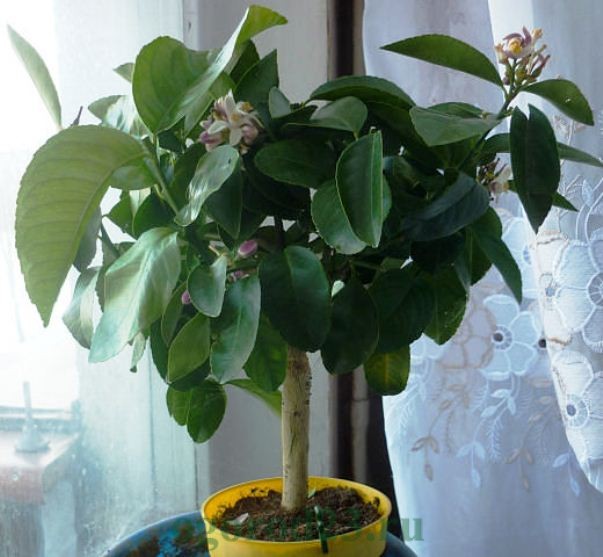 Meyer's lemon
Meyer's lemon
The number of flowers also needs to be controlled so that the vitality of the plant is not depleted.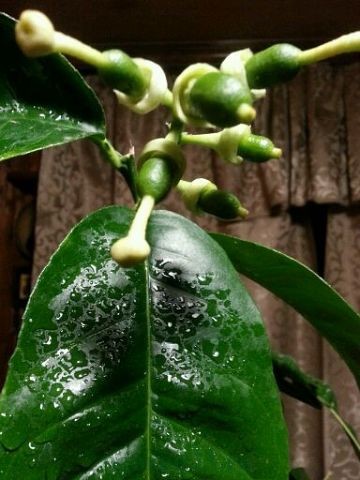 In order for the tree to develop harmoniously, at about 3 years of age, you need to start removing half of the inflorescences (the harvest will be smaller, but the fruits are larger), and leave 3 or 4 pieces from the ovaries. For the same purposes, after a year, you can leave 5 or 6 citruses. And for the future, do not leave more than 7 or 9.
In order for the tree to develop harmoniously, at about 3 years of age, you need to start removing half of the inflorescences (the harvest will be smaller, but the fruits are larger), and leave 3 or 4 pieces from the ovaries. For the same purposes, after a year, you can leave 5 or 6 citruses. And for the future, do not leave more than 7 or 9.
The growing branches can be carefully, without undue enthusiasm, trimmed by eye so that the crown has a visually attractive shape. It should be borne in mind that a short cut provokes the growth of new powerful shoots, and a long one contributes to the emergence of fruit buds.
The skeleton of a tree is considered formed after the young shoots of branches grow back, lignify. A properly formed crown gives all leaves the required amount of light and air.
How to pinch a lemon? If it actively branches, forms shoots, then the excess fragments must be removed as soon as they appear. In those shoots that are left for development, the tops are pinched after the appearance of the 6th leaf.
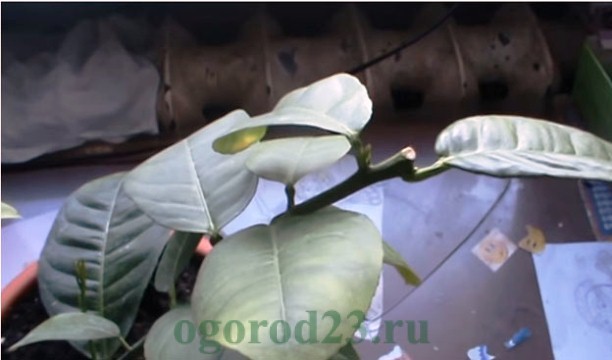
Can indoor lemon trees bear fruit?
Many people think that growing lemon from stone is a thankless job. Since it will take 5, 7 or even 15 years to wait for the fruits of such a lemon, and its fruits will be small.
Todo not wait for decades when the lemon tree begins to bear fruit, it is necessary ... You can do this in two ways during the warm season (summer or warm spring):
-
- In subdivision - the preferred type of vaccination. It is necessary to take a cultivated stem of a fruiting lemon. On the cuttings, a branch is cut off and the remaining stem is cut through the seedlings. On the stem of a fruiting lemon, slices are pointed, which are then introduced into the stems. Then you need to tie the vaccine to the tape. 2-4 buds remain on the stem of the fruiting lemon, the rest is cut off. Vaccination is covered with a plastic bag. When the vaccine grows together, the packaging can be removed.
 Vaccination of the lemon - by budding or splitting - is essential for fast fruiting
Vaccination of the lemon - by budding or splitting - is essential for fast fruiting
- Dictionary - the shoots are cut from the cuttings, a 10 cm high "stump" remains from the tree, after which a sprig of fruit lemon is taken. There is a so-called "sleeping bud" under each leaf of the branch. An incision must be made in front of this kidney. Then cut off the leaf blade, but leave the petiole. The bark is cut off on cannabis seedlings and the cut stem is placed there. Tie the vaccination site with duct tape. The cut out leaf blade will act as an indicator. If the petiole disappears within 2-3 days, it can be assumed that the vaccination was successful, if it dries up, then the vaccination has failed and it should be repeated.
Interesting thatgrown lemon stone adapts faster and better to home conditions , it is less picky than cuttings and grafted cuttings.
Why Lemon Fruit Doesn't Come From Seed:
Lemon planting rules
Lemon growing begins with planting. This stage requires maximum attention. Indeed, it depends on the correctness of this process whether the planting material will germinate, whether the seedlings will take root and whether the plant will bear fruit.
Selection of variety and seeds
At home, you can grow absolutely any lemon. However, it is recommended to give preference to undersized varieties. These include:
- Pavlovsky. An old variety that is distinguished by its ability to grow with a lack of light and moisture.
- Mayer. A mixture of lemon and orange. Has orange fragrant fruit without bitterness. Sweeter than other lemons.
- Chinese. The first harvest gives already 2-3 years after planting. The fruits ripen quickly. Differs in high productivity.
- Anniversary. Blooms profusely and bears fruit. Sour fruits with a thick skin reach a weight of 0.5 kg.Able to tie in any conditions.
- Genoa. It blooms and bears fruit 2-3 times a year. It has small fruits weighing up to 150 g. Differs in high taste characteristics.
When growing by seed, it will not be possible to select a variety. But the desired option is easy to graft onto the stock obtained by the generative method.
For growing lemon at home, it is important to choose the right planting material. The fruits from which it will be obtained must have the most correct shape and a uniform yellow color.
It is important that they are elastic, ripe, without traces of disease and pests.
The seeds are taken from the selected fruits and prepared for planting:
- Selection of suitable seeds. For planting, choose large, dense seeds with a uniform light color without any damage. Thin and soft bones, specimens with spots, holes, traces of disease and pests will not work.
- Disinfection. For 30 min. the bones are soaked in a light pink solution of potassium permanganate, hydrogen peroxide or "Fitosporin".
- Growth stimulation. To do this, use the purchased nutritional formulations "Epin", "Solution", "Heteroauxin". Self-prepared mixtures are also suitable, for example, a solution of ash or aloe juice.
Prepared seeds are used without preliminary drying. They cannot be stored for a long time. It is recommended to take several times more planting material than is actually required. This is due to the fact that not all seeds will germinate, and the strongest will have to be selected from the resulting sprouts. A few examples will help you experiment with growing grafted and unvaccinated lemons.
Pot and soil preparation
Lemon primer is also essential. It should be light, nutritious, slightly acidic
The easiest option is to purchase ready-made citrus soil. It is more profitable to prepare the soil for growing lemons yourself. For this, humus, sand, peat and leafy earth are mixed in equal proportions.
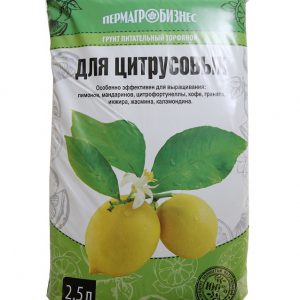
Regardless of whether purchased or homemade soil, it is disinfected before use. To do this, it is poured with boiling water, ignited in the oven or poured over with a dark pink solution of potassium permanganate.
The seeds are sown in one common container. They are planted when two true leaves appear on the seedlings in a 200-300 ml container. The pots are also disinfected with potassium permanganate solution or boiling water.
You will also need disinfected drainage, for example, shards, broken ceramics, fine gravel.
Planting lemon step by step
How to plant lemon:
- A layer of drainage 1-2 cm thick is poured onto the bottom of the container.Then the fertile mixture is poured so that 2-3 cm remain free to the edge of the pot.
- The seeds are sown to a depth of 1-1.5 cm. They are sprinkled with soil, which is slightly compacted.
- The soil is moistened with warm water with the addition of a growth stimulator from a spray bottle.
- From above, the container is covered with glass or film. Then they put it in a warm place.
Growing lime from seed at home
Growing lime from seed is a longer and more complex process than planting a cuttings. This method allows you to get strong and hardy plants that will bear fruit longer.
You can plant lime seeds in an apartment all year round. In winter and autumn, you will need a phytolamp, which is turned on for 5-6 hours. If you plant a seed in the second half of February, you will not have to highlight the lime additionally. Therefore, it is recommended to start growing the plant in late winter or early spring.
Selection and preparation of seeds
Each lime contains about 4 seeds. If you decide to buy fruits in a store, you will have to take several pieces to collect enough planting material.
Fruits must be firm, regular in shape, free of spots, damage, rot, mold and other signs of disease.
The collected bones are prepared:
- Washed from the pulp and sorted out. Select dense, light (white or cream) bones without dark spots and damage.Soft and empty seeds are thrown away.
- Disinfect - soak for 30 minutes. in a light pink solution of potassium permanganate or hydrogen peroxide.
- To stimulate germination, to make the seedlings stronger and more hardy, the seeds are soaked for 30-60 minutes. in humic fertilizers.
The treated seeds are allowed to dry, after which they are planted in the prepared soil.
h3> Pot and soil
In order for the seeds to germinate quickly and the seedlings to feel comfortable, it is important to use the correct soil for planting. Lime loves fertile, loose soil
In heavy soil, the plant begins to ache and rot.
The easiest option is to buy a universal soil mixture at a gardening store, mixing it in a 2: 1 ratio with river sand. Prepare the soil yourself. To do this, take:
- garden land - 1 part;
- humus - 1 part;
- sand - 1 part.
A glass of ash is added to the bucket of the mixture - it normalizes acidity and acts as an additional fertilizer.
The soil is disinfected in one of the following ways:
- pour boiling water over;
- poured with hot copper sulfate;
- watered with a dark pink solution of potassium permanganate;
- calcined in the oven.
Drainage must be used: shell rock, broken ceramics, crushed expanded clay, fine gravel.
It is recommended to sow more seeds than needed. Not all planting material will germinate. Seeds are sown in one common container, such as a wooden box or plastic tray.
For the first pick, use containers with a diameter of up to 6 cm. It is desirable that these are special flower pots. For each next transplant, take a container 3-5 cm larger than the previous one.
The containers are also disinfected by soaking them in a dark pink solution of potassium permanganate for half an hour or pouring them over with boiling water.
Planting and care during germination
Step-by-step instructions on how to grow lime from a seed at home:
- A 1 cm thick drainage layer is poured at the bottom of the box, the rest of the volume is filled with soil.
- The soil is moistened with warm water from a spray bottle.
- The bones are buried in the ground by 1.5-2 cm, a distance of at least 5 cm should remain between them.
- After planting, the soil is watered, the boxes are covered with foil and removed to a warm place.
The seeds germinate from 3 weeks to 2 months. Until this moment, the crops should be under the film. The soil is moistened as it dries from a spray bottle with warm water. Every day the film is slightly opened for 30-60 minutes. for airing.
After seed germination, the duration of airing is increased; after a week, the film is completely removed.
Seedlings are placed on a windowsill. The east or west side of the apartment is best suited. If you put lime near the south window, the immature plants will have to be shaded during the day. On the north side, the seedlings will not have enough natural light.
Water the sprouts from a spray bottle with warm settled water as the soil dries out. They moisten not only the soil, but also the plants themselves.
It is important to protect seedlings from drafts. Otherwise, they will get sick with a black leg or die.
The ideal temperature during this period is + 25 ... + 26 ° С. The minimum temperature is + 12 ° C.
When 2-3 true leaves appear on the seedlings, they are transplanted into individual pots. The strongest specimens are chosen for further cultivation. They are distinguished by an elastic thick stem, bright color of leaves, and short internodes.
A centimeter layer of drainage is poured onto the bottom of the lime transplant pot. The rest of the volume is filled with soil so that 1-2 cm remains to the edge of the pot.
The seedling is carefully removed from the common box using a wooden stick or spoon, taking care not to damage the roots. The plant is transplanted into a pot without deepening the root collar. After transplanting, the lime is watered with warm, settled water and allowed to take root for at least two days away from the sun.
Lemon pests and diseases
Appearing white flies may indicate stagnation.Their larvae feed on roots and cause significant damage to the plant. To combat them, insecticides of various types are used - irrigation solutions and aerosol forms for the destruction of insects that have managed to hatch. Karbofos and Aktelik are quite effective against these insects.
It is necessary to regularly look at lemon leaves, on which ticks and scale insects can settle. Outwardly, mites are like tiny spiders. They are given out by the color orange or brown, which stands out noticeably against the green background of the back of the leaves. They tighten the damaged areas with a thin cobweb, by which it is easy to recognize pests. Rinse the twigs and leaves on both sides at intervals of three to four days several times under a high pressure shower head. Multiple infusions are effective

- garlic (infuse 1 medium-sized head in 0.5 l of water),
- onions (1 onion, finely grated, poured with a liter of water),
- bay leaf (2-3 leaves per 0.5 liter can of water)
- strong brewing of green tea (for 2 cups of boiled water, 2 tablespoons of dry tea leaves).
Scabbards look like small brown turtles, motionless and tightly attached to leaves. It is difficult to deal with them. Three times at weekly intervals, wipe the plant, including leaves on both sides, twigs and trunk, thoroughly with a mixture of soap and kerosene, taken in a ratio of 1 / 0.5. Cover the ground with cardboard or polyethylene, wrap the trunk at the very bottom with a narrow bandage to prevent the penetration of liquid into the root system.
Lemons often get sick from improper care. Brownish leaves on an outwardly healthy plant, and even during the flowering period, is one of the ailments. In this case, reconsider the conditions for keeping the flower, it may make sense to transplant it. But in this case, choose a soil different from that at the present time. Perhaps it was the acidity of the soil that caused the disease.
Video about pests of indoor lemon
As for the human body, disease prevention is important for citrus fruits. To prevent diseases, observe the regime, carry out transplantation, pruning of damaged areas. Sometimes a sudden illness can be dictated by the depletion of the plant itself. In this case, limit the flowering to a few buds, and remove the rest, no matter how sorry. Each house has its own separate microclimate, which is not always suitable for lemon. The task of the plant owner is to adapt it to existing conditions gradually.
Sometimes the process of caring for a lemon at home is comparable in terms of the hassle of caring for small children - it is difficult at the beginning, but all the work is rewarded when the tree begins to grow actively.
Citrus trees are quite expensive, for example, a lemon tree about 45 cm high will cost 2.5 thousand rubles. Therefore, many people prefer to grow lemon on their own - especially since the seeds are readily available and can be bought in any supermarket. You can also buy fairly inexpensive seeds of varietal lemons (and other citrus fruits such as tangerines, oranges).
For those who decided to try their luck with a seed from a purchased lemon - this article.

Young seedlings of lemon, age 1 month.
Care
Gardeners note that lemon is a capricious plant. Plant development is highly dependent on the composition of the soil. The following composition is approximately recommended: 1 part of sand, 1 part of manure, 3 parts of leafy soil and 2 parts of loam. It is advisable to choose a pot from baked clay.
You will find more information on caring for indoor lemon in our material.
Watering
Too good is also not good, we can say about excessive moisture, a plant regularly exposed to overflow will die due to rotting of the root system
It is necessary to water the lemon as the soil dries up, it is important not to forget about the timely loosening, which is not in vain called dry watering - the evaporation of moisture after loosening is significantly reduced
Subtropical plants love spraying, air humidity during the heating season is easy to regulate with a container of water. Evaporating, it maintains the microclimate of the room.
NOTE! Watering and feeding in winter should not be excessive, the plant is resting.
Water the plant abundantly with settled water. In winter, it is advisable to warm up the water
In summer, water 2-4 times a week, in the afternoon. In winter, watered once in the morning.
You will find more tips for caring for homemade lemon in winter in a separate article, and here we talked about the features of caring for a tree in autumn.
Top dressing
The ideal option for feeding lemon is the alternation of organic and mineral fertilizers. In winter, it is necessary to reduce the amount of fertilizer, low temperatures have a negative effect on absorption.
Important: do not water dry soil with top dressing, the lemon will burn the root system.
Read about how and what to feed indoor lemon at home here.
Growing
As each spring grows, the lemon needs to be transplanted into a pot 5 centimeters more than before, it is not necessary to plant it in a pot for growth.
There is no need to replant the grown lemon either, every spring the top layer of soil in the container where your tree lives is replaced with humus or fertile garden soil with the addition of humus, and this is enough for him.
The complex fertilizer Zdraven 'for citrus fruits has also been developed and is widely used; it contains the whole complex of macro and microelements necessary for the growth and fruiting of plants.
A grown lemon can be placed in the garden for the summer, the place must be protected from winds and other possible adversities, a sudden change in lighting can be bad, be careful.
Now you know how to grow lemon at home, and most importantly, how to do it right. Now let's look at the main diseases and pests of lemon to protect our crop.
Useful video on how to properly transplant seedlings into separate pots:
Pests and diseases
Aphids, scale insects, worms or spider mites may be interested in your lemon, if there are few pests, shake them off into a special container so that they do not scatter, from the trunk with a soft toothbrush, and with a cotton swab from the leaves, and treat the plant with a soapy solution of anabasine sulfate.
ATTENTION! If there are a lot of pests, spray the plant with Actellik, Ditox or any other insecticide for indoor plants.
Sores that appear on the bark must be cleaned and treated with copper sulfate, mold, wherever they settle, you just need to remove with a damp cloth.
It also happens that the leaves of indoor lemon fall off, curl or change their color. We talked about the reasons for this phenomenon, as well as about ways to combat it in a separate article.
Diseases and pests of lemon
For many lovers, the leaves on the lemon turn yellow and fall off. This can be caused by:
- dry air;
- inadequate nutrition;
- high temperature in the room in winter;
- when infected with a spider mite (you need to fight it with Fitoverm, Akarin).
Often novice gardeners complain that the indoor lemon has shed its leaves. What to do in this case? It is necessary to see which of the points of care is not being performed, and change the mode. Perhaps this is a consequence of the transplant. If done incorrectly, the root system can be damaged, leading to leaf fall. Therefore, a lemon is transplanted into a new pot in the first years of life every 2-3 years.
Leaves and stems, especially young ones, can damage aphids, scale insects, whiteflies, mealybugs. To get rid of them without the use of chemicals that are undesirable in the apartment, use an infusion of garlic. To prepare it, the garlic is chopped, infused in water for 5 days. Filter, pour 6 g of infusion into 1 liter of water, spray the plant.But if the pests have spread over a large area, such a remedy is unlikely to help.
Will there be fruit?
If you plant a room lemon with seeds, then it will begin to bear fruit in 7-9 years, if by cuttings - for 3-4 years, by cutting - in 1-2 years.
There are the following methods to speed up fruiting:
- Cleavage. Make an incision on the seedling and attach a stalk from a fruiting tree, wrap it with electrical tape, cover it with plastic wrap on top, as it grafts, remove the film.
- Budding Cut the seedling to 10 cm and graft a fruiting stalk to it. Both methods significantly speed up fruiting. The plant may not bloom if the cutting was taken from a tree that has not previously produced fruit.
Lemon fruits have both beneficial and medicinal and harmful properties. You can read about them in our article.
Failure to comply with the temperature regime, insufficient lighting, irregular pruning and disease damage, the plant will not bear fruit.
You can make lemon bloom by cross-pollination during the flowering period within the same cultivar.
Which is better to buy - an adult plant or cuttings
For beginner flower lovers, you can already buyadult plant : There will be fewer problems and problems associated with growth.
It is true that the price of such a lemon will be higher than a young seedling. Seedlings may be worth200 rubles, and an adult plant is about1000 rubles .
And yet it is much more interesting to grow it out of a tree by watching how it grows day after day. Better yet, fully develop yourstone wood .
It is not easy, but it is possible to get a healthy, beautiful and fruitful lemon. During5-7 years (with the right approach) you can admire the view of an evergreen tree and drink aromatic tea with your own lemons.
Preparing the soil for lemon pits
Before you start planting the seeds in the ground, you need to prepare the pots and soil. For active germination of seeds, both a special soil for citrus plants, it is sold in flower shops, and homemade soil are ideal. If the purchased land is already ready for use, then the homemade soil needs to be given a little time and attention. It should consist of:
- ½ sod land;
- ½ humus earth;
- a small amount of fertilizers - charcoal and / or peat.
Advice. Vases for planting must be taken spacious and deep so that the root system has a place for its growth and development.
Planting a seed in the ground:
- Expanded clay, pieces of charcoal or polystyrene are placed at the bottom of the flowerpot (this material will serve as drainage).
- The pot is filled with prepared or purchased soil.
- The earth is moistened with rain or purified water.
- Several grains are planted in a container, immersed to a depth of 0.5-1 cm.
- The pot is covered with a film to create a greenhouse environment.
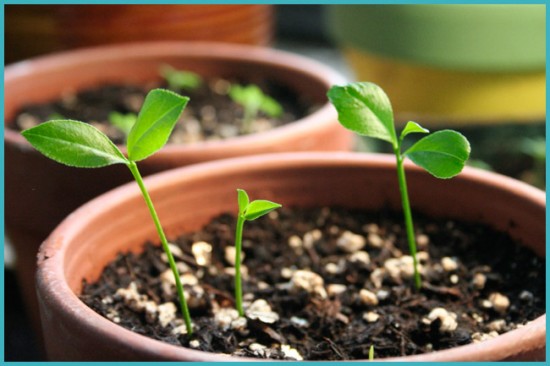 When properly planted, sprouts appear quite quickly.
When properly planted, sprouts appear quite quickly.
After 2-2.5 weeks, the first sprouts will already appear on the surface of the soil, the strongest of them are transplanted into another container for further germination.
Indoor citrus pests
The reasons for the appearance of diseases in indoor lemon:
- fungus;
- various harmful bacteria;
- viruses.
Important! Diseases can be seen by the appearance of spots and flaws on the foliage, a decrease in its size, the appearance of various growths and plaque.
Common citrus tree diseases:
- gommosis;
- scab;
 Lemon scab disease
Lemon scab disease
- root rot;
- sooty fungus;
- stickiness of the sheets (a sign of the appearance of a scabbard).
Hommosis is one of the most serious diseases. It appears in the lower part of the tree, gradually spreading to its upper part (tubercles with a dark brown liquid form on the trunk, "burns" and cracks appear on the affected branches). Hommosis is very difficult to treat. In this situation, only treatment with copper sulfate and stripping of branches can help.
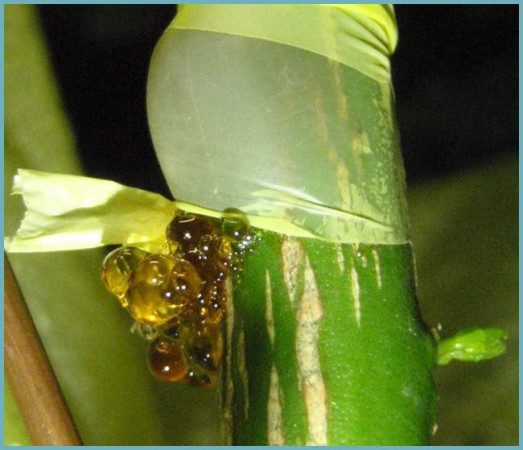 Manifestation of hommosis
Manifestation of hommosis
Sooty fungus is also quite common in citrus fruits. It manifests itself in the form of dark spots on the foliage, they have a bad effect on the growth and development of the lemon. You can fight it with the help of warm water, the stains formed are washed off with it, thereby freeing the leaves from plaque.
Sticky leaves are the result of the appearance of the scale insect. You can fight it with ready-made products that are sold in specialized stores, as well as with the help of folk remedies.
Helpful tips and tricks can help you grow your homemade lemon tree effortlessly. Take advantage of them, the result will not be long in coming!


